At its most transformative, the camera has the capacity to shape both time and space, preserving a simulacrum of life that will eventually supplant the real with the dream. “The eye,” avant-garde jazz musician Cecil Taylor warbles midway through a performance caught in The Silent Eye, is “the indivisible subterranean matrix.” The new work from filmmaker Amiel Courtin-Wilson is all about that lucid eye, the spectral death dance that cinema orchestrates between the physical and the spiritual.
Filmed across three days in early 2016, The Silent Eye captures the legendary pianist and poet Taylor, 88, and Japanese Butoh performer Min Tanaka, 72, friends and artistic kindred collaborating free form in the former’s Fort Greene brownstone. Loosely demarcated into several improvised tracks and a spoken word interlude, it’s an ostensibly casual performance piece that comes to resemble less an informal session between two old pals than the communion of slippery entities on astral terrain.
The performance takes on a familiar rhythm: Taylor, expressively freestyling at his careworn piano while Tanaka responds in movement, weaving and contorting to the sounds, face fixed in motion rapture. It’s a game of tag in which Tanaka is alternately the jazzman’s cosmic marionette and his playful tease, each inviting the other into guessing the form the other will take. Taylor might grin as he maniacally pounds the keys, watching Tanaka bob like a demented meerkat, or ease back into reflective pause, drawing out the Butoh artist’s paradoxical capacity for stillness and grace.
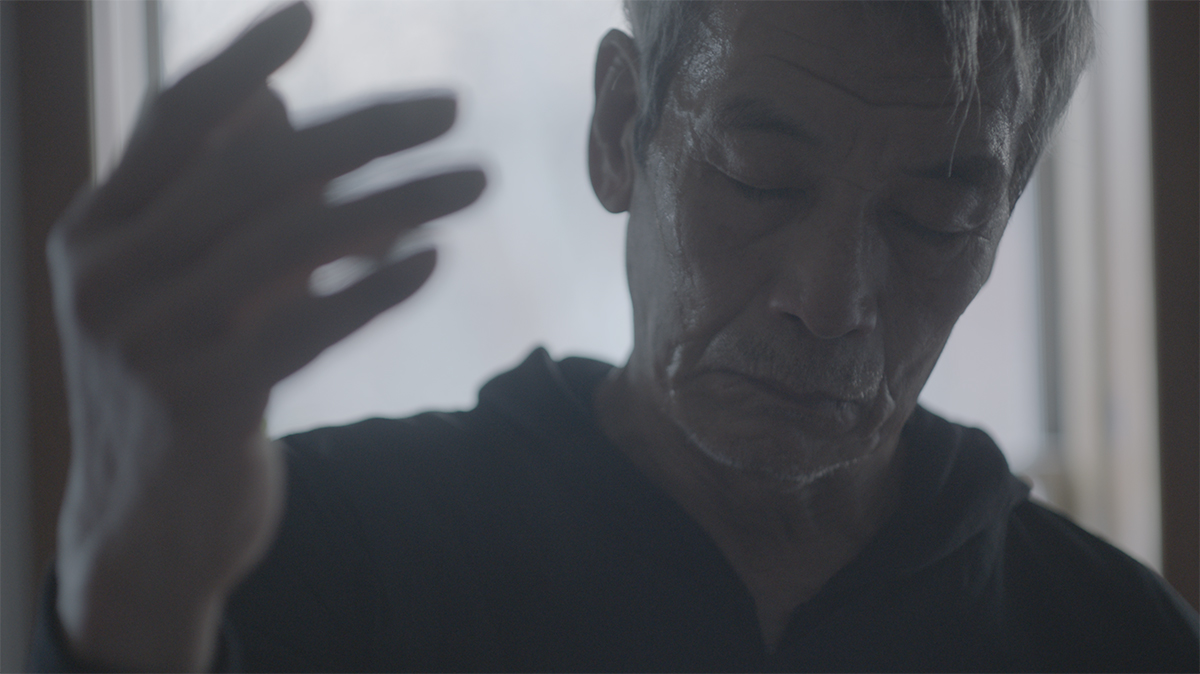
Min Tanaka, The Silent Eye, Amiel Courtin Wilson
Courtin-Wilson’s gift for capturing the tension between the corporeal and the spiritual — honed across films like Hail (2011) and especially the woozy, somnambulist Ruin (2013) — is in full flight here, alchemising Taylor’s Brooklyn residence and ascribing an otherworldly aspect to these physically ageing men. Viewed in abstract silhouette, Tanaka throws celestial shapes; with his out-of-focus form; he might be stepping down the gangway of the alien mothership from Close Encounters of the Third Kind.
Though the film never leaves Taylor’s apartment, the space feels unbounded by walls. Director of photography Germain McMicking works with the natural winter light to suggest parallel dimensions bleeding into each other, the handheld camera pushing into corners of the apartment only to find untethered pockets of nothing, like a video game avatar gone off grid. At one point he stays transfixed on the tiny splinters in a double-glazed window, and the cracks form a circular portal to the sun that beckons us to head toward the light. Elsewhere, the camera catches glimpses of the pictures on Taylor’s wall, which serve as a kind of shrine to other ethereal spirits: Billie Holiday, Michael Jackson, Eartha Kitt, smiling in collusion from the other side. The tableau also conjures the spectres of history: faded portraits of long-gone jazzmen, a lithograph of a native American leader, and the weight of 20th century Japanese tumult on the lines in Tanaka’s face and gestures.
Shooting digitally on a 2K ARRI Alexa Amira, McMicking and Courtin-Wilson’s camera has the effect of transforming the intimate into the infinite, where a brief image of the outside skyline somehow feels diminished in comparison to the dance that plays out inside. A macro-tight shot on Tanaka’s profile collects a single drop of falling sweat that forms a refracted diamond, while what sounds like a passing subway car — a ghost train, perhaps — rumbles offscreen, spirited to another realm.
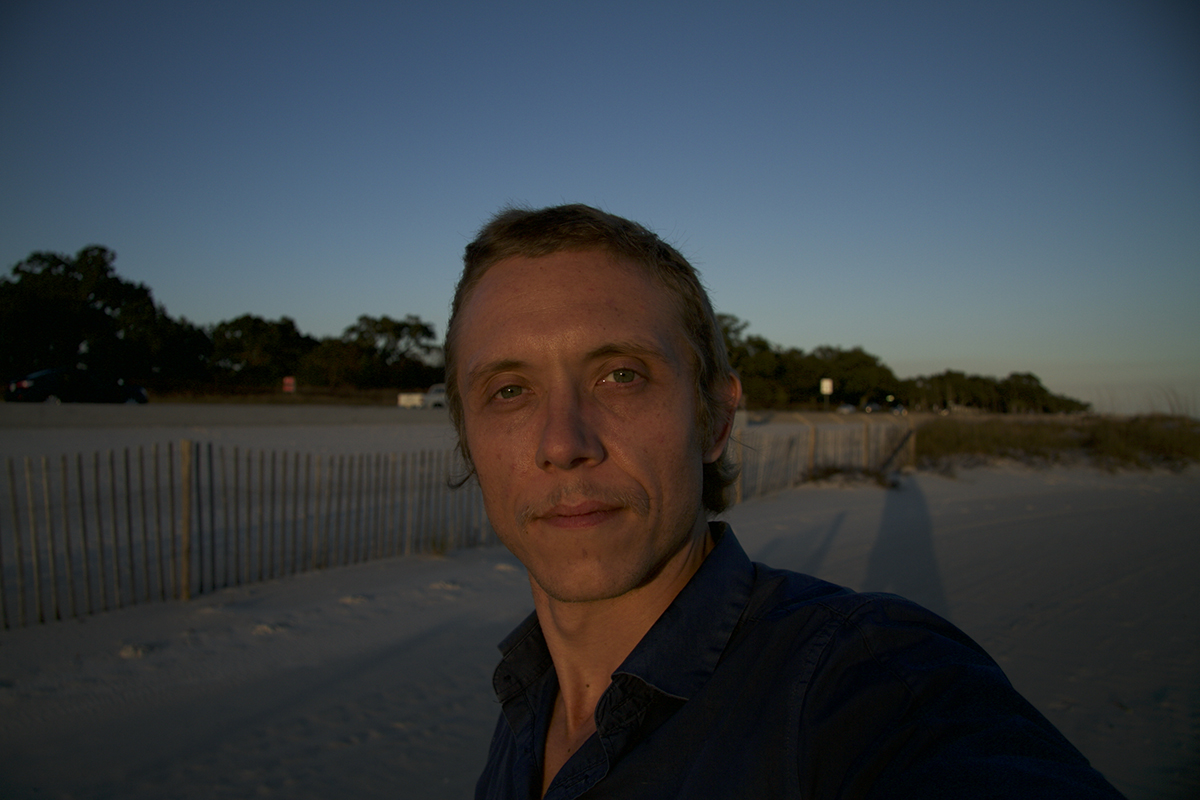
Amiel Courtin-Wilson, photo courtesy the artist
The film’s non-performance breaks are almost primal. In a disorienting sequence, the frame goes tight on Tanaka’s hand swaying in some phantom breeze, while the feedback of disembodied chords swirls around it like an ancient volcano threatening eruption. These aural interludes come not from Taylor but sound designer Rosalind Hall, whose collages — strangled, discordant saxophone set to exaggerated heartbeats and ambient noise — loom like some studio applause track that’s just reached the Earth having been dispatched a hundred million years ago.
Courtin-Wilson has developed an ambivalent relationship to narrative, from the subjective immersion of Hail through the disorientating audio-visual passages of Ruin and his recent video art piece, Charles (2015). Indeed, The Silent Eye is born of the art world: the project was funded by the Robert D Bielecki Foundation and premiered at the Whitney Museum of American Art last year. Courtin-Wilson has called it an in-between work, anticipating what he’s described as a time travel sci-fi biopic of Taylor. The Silent Eye’s transformative power certainly bodes well for that project. Courtin-Wilson gets cinema as art’s temporal vessel, the craft that navigates dimensions and disrupts our learned cognition.
That sensation of moving through time and space extends to the players themselves, whose physical forms can barely contain the spirits shimmying to bust loose. In one of many extraordinary scenes, Min Tanaka’s head tilts back to the sky mid-film, and Cecil Taylor’s chords recede into the sounds of heavy, overdubbed breathing, as though the weight of the physical realm is finally about to be lifted. It’s followed by a cut to a simple shot — ever so brief — of an empty chair and piano. In that moment, it’s enough to believe that Cecil Taylor has ascended.
–
The Silent Eye, director, producer, editor Amiel Courtin-Wilson, line producer Kate Laurie, director of photography Germain McMicking, editor Alena Lodkina, sound designer Rosalind Hall; Antenna Documentary Film Festival, Museum of Contemporary Art, Sydney, 14 Oct
Top image credit: Cecil Taylor, The Silent Eye, Amiel Courtin Wilson
From the Sundance Institute and New Zealand Film Commission comes a small, lovely film about cinema’s hidden history in Afghanistan. With the country’s future still on a precipice, a group of men come together to rescue and restore thousands of hours of celluloid film footage — some concealed, some burned during the Taliban’s reign — in the at-risk national archive. At the helm of the restoration project is Ibrahim Arify, the new Director of Afghan Films, established in 1968 by Mohammed Zahir Shah with the assistance of US funds. Arify is a serious and fastidious figure who watched with sorrow from afar over the decades as his homeland succumbed to rolling invasions. Though there are tonnes of unprocessed film that will deteriorate without intervention, the archive project is framed from the beginning as being about more than the delicacy of a dying medium: it signifies the reclamation of his country. “It’s crucial we find our cultural heritage again,” says Arify. “Our own culture. Not Arab, not American, not Russian. We need our own culture. We need to be able to see Afghan films across the country.”
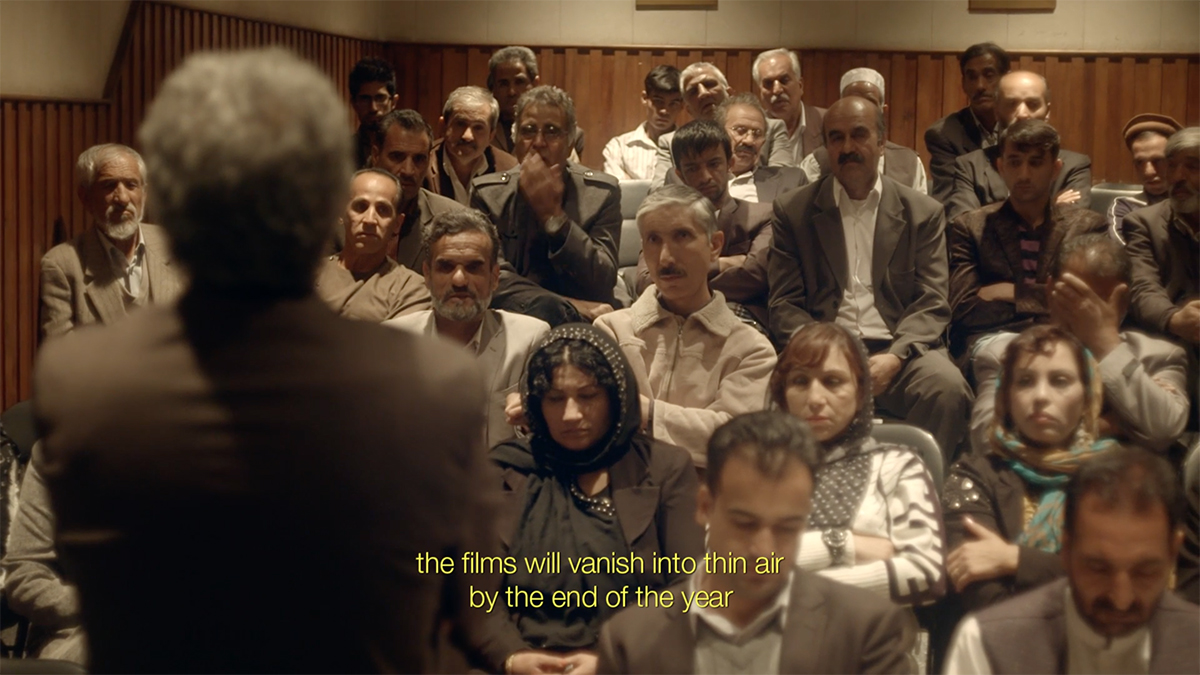
A Flickering Truth
The film’s structure unspools as a long trawl through warehouses overflowing with newsreels, unprocessed negatives and forgotten films. Bullet holes in the walls cast thin beams of light across the dusty film cans. Some of them are unsalvageable, their celluloid chemicals have long since bled into the ground, but director Pietra Brettkelly makes good use of the resulting twisted, abstracted images (part of the film’s pleasure lies in Jacob Bryant’s graceful cinematography, which combines these interstitial montages with skilled handheld camerawork that invites a low-budget cinematic intimacy).
Every day yields new discoveries, which we see thrown onto a wall, a projector ticking away behind us and the faces of Arify and his team full of wonder and pain. US President John F Kennedy visits the Shah in the 1960s. The mountains of Helmand, a distant province now run by the Taliban, hover across the wall. We see the Palace of Forty Columns, surrounded by flowering trees, now destroyed. We see Kabul in all its seasons; King Shah’s wife and family diving into a pool of shimmering blue; President Daoud in 1973 flanked by terrifying rows of marching soldiers. We see dramas of lost love beginning with the archive’s oldest film Love and Friendship (1946) and House of History (1992), in which Kabul appears like a black-and-white war-stricken dystopia. And we see an abundance of army footage: soldiers dropping out of planes in parachutes and tanks rolling across Kabul in 1978 for the Saur Revolution. Among the unedited negatives, Arify finds one labelled “The Execution of President Dr Najib” from 1996. “This is a critical piece of evidence,” he says, motioning to the flickering image on the wall. “Should anyone question who killed President Najib, we can show them the Taliban did it.” All of it was captured by the cameras of Afghan Films.
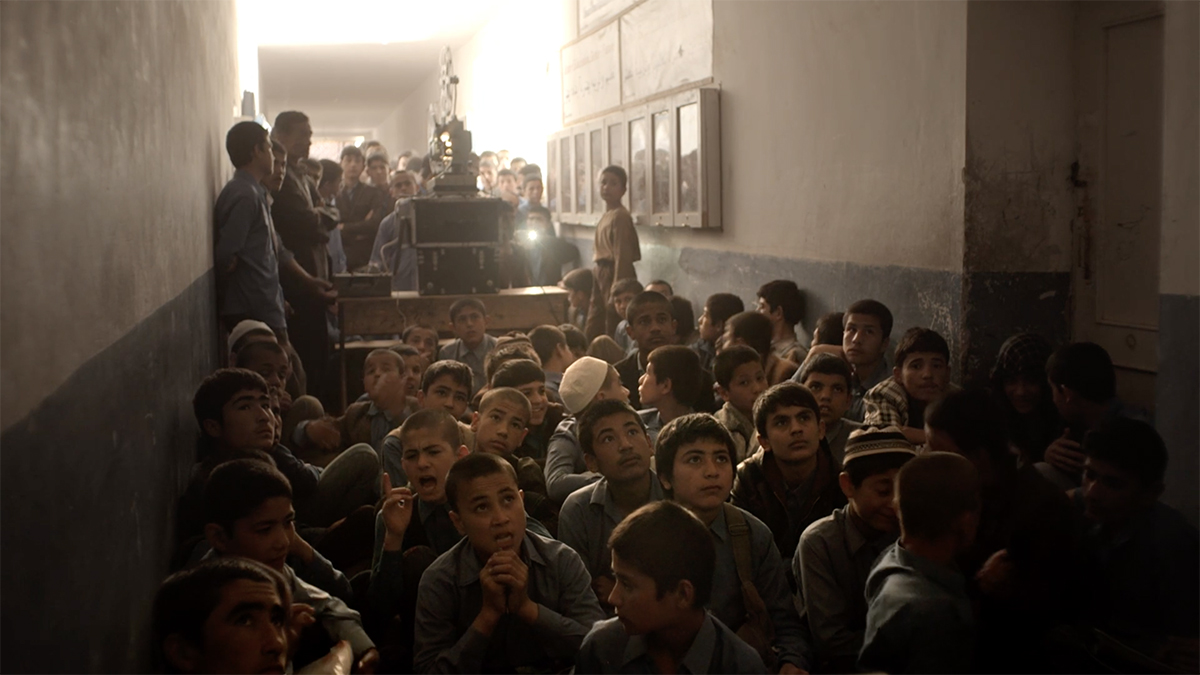
A Flickering Truth
A picture begins to build: a fragmented chronology of an almost-nation, in which history is savagely, daily contested. In the West, nostalgia is ever-present in popular culture, in the ironic forms of cassette-shaped iPhone cases, Jurassic Park T-shirts and cafes with menus devoted to childhood cereals. With its visions of grand, long-destroyed cities and almost-lost romances, A Flickering Truth trades in an altogether different kind of nostalgia. Each clip of archival footage shows not just a relic of Afghanistan’s lost history, but a snapshot of its many, potential lost futures. The film is eulogistic in tone (aided very much by Benjamin Wallfisch’s floating score), while reaching for optimism.
As Ibrahim Arify’s efforts culminate in a film festival, named We are who we are not, and a mobile cinema touring to rural schools (avoiding Taliban-controlled provinces), the film lands on images of children watching the rescued material, thereby projecting hope for social cohesion at last. The memory and threat of violence remains vivid — one former actress recalls shooting a film with the very real fear that “music, cinema, culture would cease to exist” in Afghanistan. But A Flickering Truth connects the archive to a much broader project: cinema as inextricable from history and from hope itself.
–
A Flickering Truth, 2015, director, writer Pietra Brettkelly, cinematographer Jacob Bryant, original music Benjamin Wallfisch, editors Irena Dol, Margot Francis, Ken Sparks, Jacob Schulsinger, Cinzia Baldessari, Cushla Dillon; in Dari and English, distributor Umbrella Entertainment
Top image credit: A Flickering Truth
In Afghanistan, a group of cinephiles gather to rescue the country’s film archive, much of which was burned by the Taliban. This 2015 documentary, New Zealand’s Oscar candidate, unspools rarely seen archival films and footage of the Afghanian Shah, JFK visiting in the 1960s and once grand cities destroyed by the USSR, the US and the Taliban. RealTime’s reviewer calls A Flickering Truth “a eulogistic, cinematically-shot documentary” that speaks to the role of film in building a new cultural narrative of hope and cohesion for a war-torn country.
Three DVD copies courtesy of Umbrella Entertainment.
Email us at giveaways [at] realtimearts.net by 5pm 18 August with your name, postal address and phone number to be in the running.
Include ‘Giveaway’ and the name of the item in the subject line.
Giveaways are open to RealTime subscribers only. By entering this giveaway you consent to receiving our free weekly e-dition. You can unsubscribe at any time.
A torch light cuts through the darkness. The face of a child grins from the shadows, cocooned in a tunnel of rubbish. “We’ll make a space here to sleep!” he declares, rolling happily in layers of plastic. This evocative opening of Wang Jiuliang’s Plastic China expresses the film’s implicit message in imagistic form: the more affluent we become, the more we are carving out homes built on rubbish. But for all its subtle commentary on a global cycle of production, consumption and waste, Wang’s new documentary is anything but hectoring social comment. His human subjects exude a warmth and aspirational desire that throws the social, economic and environmental complexities of our world into sharp relief.
Wang initially made a name for himself as a documentarian with Beijing Besieged by Waste (2011) (trailer below), an alarming exposé of the numerous unregulated rubbish dumps laying siege to China’s capital as its new wealthy and middle classes embrace a throwaway lifestyle. Plastic China was six years in the making, as Wang furthered his investigation of global waste disposal practices in the wake of his first film’s success. Researching in the US, he was shocked to discover massive shipments of American refuse bound for his homeland. In China, the rubbish is recycled, mostly in tiny plants surviving on wafer-thin profit margins made possible by lax safety and environmental standards. Following the rubbish trail home led Wang to the recycling plant we see in Plastic China, located near Qingdao on China’s north coast.
The plant we see is run by Kun, a former farmer in his late 20s with a five-year-old son. He explains to camera that although recycling plastic produces minuscule profits, his income is still higher and more consistent than when he worked the land. Kun and his wife labour hard, feeding large piles of plastic into an industrial shredder by hand. The strips are then melted and shaped into tiny reusable pellets. Rather than recycling, this is actually down-cycling, converting cheap plastic goods into lower grade plastics that are then used to produce yet more disposable items. The down cycling process creates a putrid liquid that fouls local waterways and fumes that pollute the air. Kun endures all this so that he can raise the funds to educate his child.
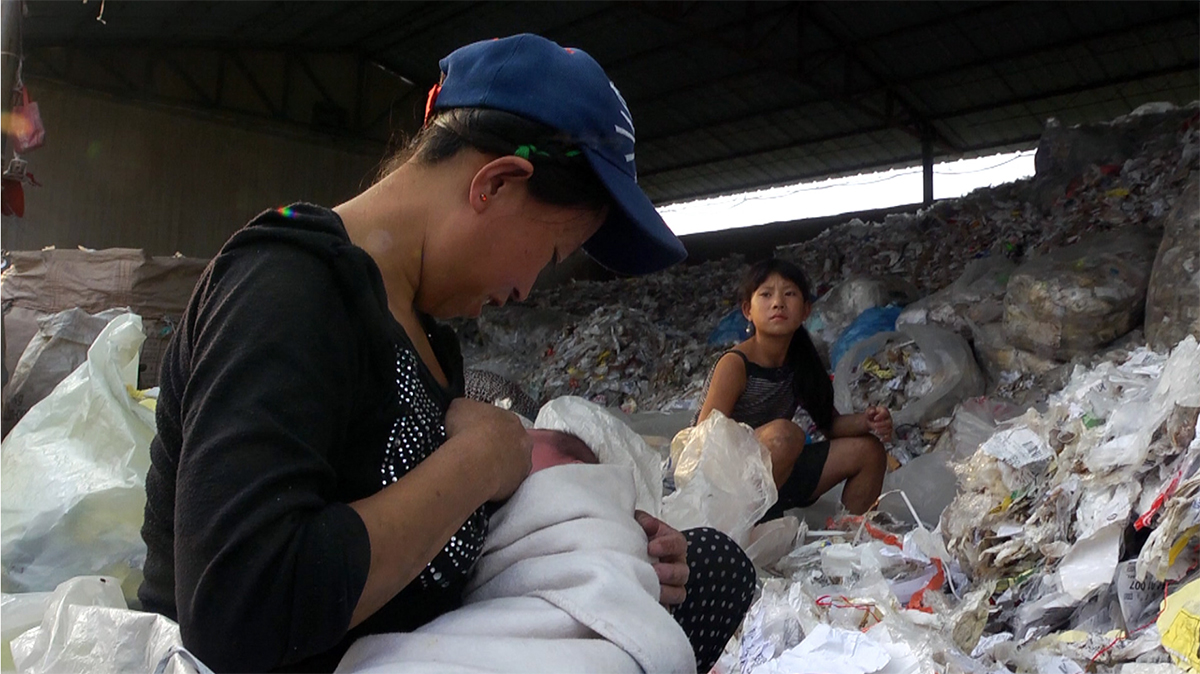
Plastic China
At the other end of the aspirational scale is Peng, a father of five who labours in Kun’s plant for the equivalent of about six dollars a day. The predicament of his 11-year-old daughter, Yi Jie, provides the film’s emotional nexus, her desire for schooling and the chance to transcend her grim surrounds a counterpoint to her father’s wayward alcoholism. Yi Jie is well aware of what her family lacks as she eyes the glossy advertisements from magazines pulled from the imported waste. She and her younger brothers build a “computer” from old boxes, and she gleans a few words of English from a deck of flash-cards rescued from the rubbish. Her family’s poverty heartbreakingly precludes Yi from grasping the opportunities she can see all around her.
Although the situation Wang captures is grim, Plastic China resists the temptation to sermonise or provide smug ‘what we can do to help’ solutions. The film also resists easy finger-pointing regarding the pollution pumped out by Kun’s recycling operation, instead adopting a more emotionally detached tone that shows rather than judges. Yi Jie and her brothers live in atrocious conditions, and Kun’s family is barely one step up the social ladder. They are surrounded by images of the good life on television and, more poignantly, in the rubbish they recycle. They have every right to aspire to improve their situation, and Kun’s family at least appears to be on the way to something better, even as Yi’s family appears mired in a poverty trap. Towards the end of the film, Kun takes his family on a visit to Beijing, where they gaze in wonder at the expanse of Tiananmen Square and the towers stretching to the horizon. “You have to get an education,” Kun urges his son, “so that in the future you can bring your dad to live in Beijing. This is where the rich people live.” Given Kun’s drive and intelligence, he and his son might just pull off this dream.
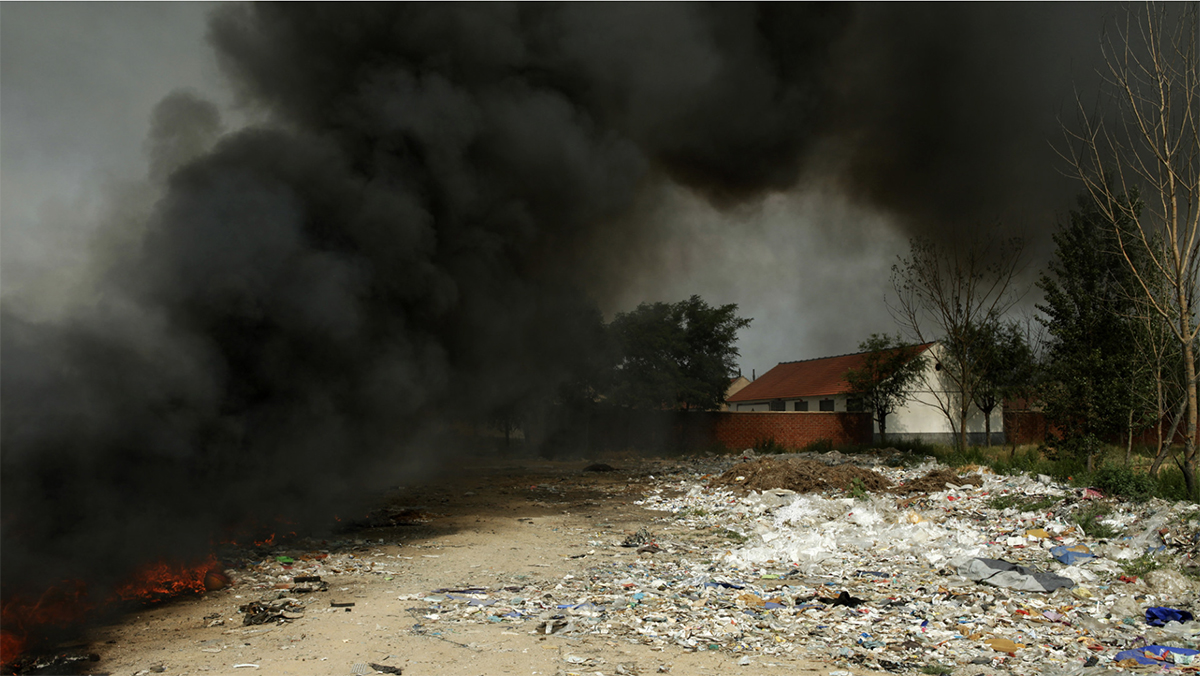
Plastic China
Yet the implicit question in all of this is where does the aspirational cycle end? The highlife enjoyed by the West and China’s rich and middle classes is supported by the cheap labour of others, even as those labouring scramble to climb over each other to reach the top of the pile. Meanwhile, we all consume more and more, and produce ever more rubbish, in an ever intensifying cycle of environmental degradation. Why do we all aspire to throw away so much? Are any of us willing to lower our material conditions so that those on the bottom can have something comparable without completely destroying the planet? As Plastic China concludes, another load of imported rubbish is unloaded as Yi Jie and her siblings play among the scraps.
Wang’s sophisticated film is one of a number of highly successful works to emerge in recent years produced by CNEX, a non-profit group founded 10 years ago to foster independent documentaries across Taiwan, Hong Kong and mainland China. CNEX has helped filmmakers like Wang tailor their work for a broader global audience. While encouraging the prolonged, empathetic engagement with subjects that has long characterised Chinese documentary, CNEX has urged directors to adopt tighter editing, shorter running times and touches like intertitles to make works more accessible to international viewers.
The result of CNEX’s efforts has been a string of recent titles acclaimed at film festivals around the globe, including A Young Patriot (Du Haibin, 2015), The Road (Zhang Zanbo, 2015) and The Chinese Mayor (Zhou Hao, 2014). Plastic China is one of the first Chinese works to cast its gaze beyond China’s shores and consider the complex relationship between Western lifestyles, Chinese aspirations and lingering, entrenched poverty inside the People’s Republic. If China is plastic, Wang’s film shows us, it’s because we became plastic first. If China is polluting, it’s because she has followed the West’s lead. This is a system that implicates all of us, linking the recycling bins outside our homes to the lives of small children in China. Wang may provide no solutions, but he asks questions addressed to us all.
–
Plastic China, director Wang Jiuliang, producer Ruby Chen, CNEX, People’s Republic of China, 2016, Human Rights Arts and Film Festival, ACMI, Melbourne, 4–18 May
Top image credit: Plastic China



